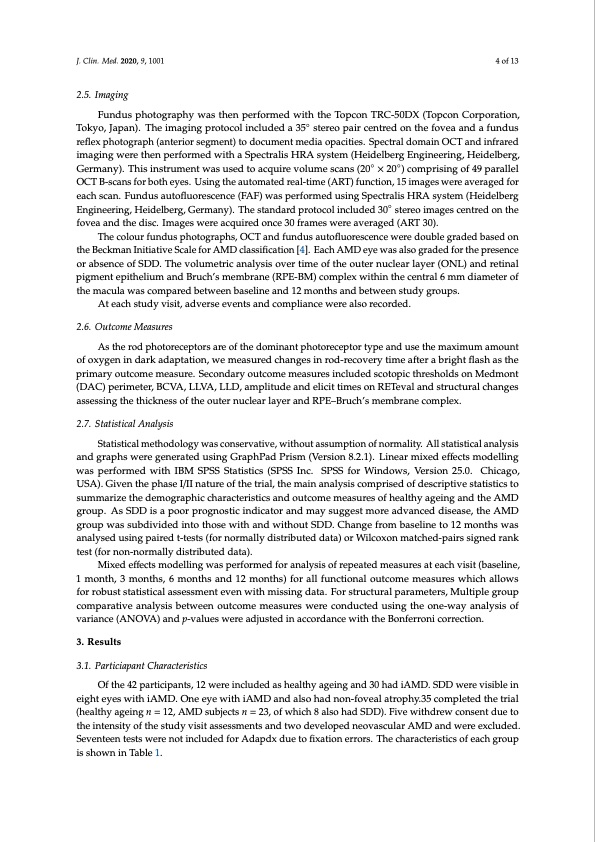
PDF Publication Title:
Text from PDF Page: 004
J. Clin. Med. 2020, 9, 1001 4 of 13 2.5. Imaging Fundus photography was then performed with the Topcon TRC-50DX (Topcon Corporation, Tokyo, Japan). The imaging protocol included a 35◦ stereo pair centred on the fovea and a fundus reflex photograph (anterior segment) to document media opacities. Spectral domain OCT and infrared imaging were then performed with a Spectralis HRA system (Heidelberg Engineering, Heidelberg, Germany). This instrument was used to acquire volume scans (20◦ × 20◦) comprising of 49 parallel OCT B-scans for both eyes. Using the automated real-time (ART) function, 15 images were averaged for each scan. Fundus autofluorescence (FAF) was performed using Spectralis HRA system (Heidelberg Engineering, Heidelberg, Germany). The standard protocol included 30◦ stereo images centred on the fovea and the disc. Images were acquired once 30 frames were averaged (ART 30). The colour fundus photographs, OCT and fundus autofluorescence were double graded based on the Beckman Initiative Scale for AMD classification [4]. Each AMD eye was also graded for the presence or absence of SDD. The volumetric analysis over time of the outer nuclear layer (ONL) and retinal pigment epithelium and Bruch’s membrane (RPE-BM) complex within the central 6 mm diameter of the macula was compared between baseline and 12 months and between study groups. At each study visit, adverse events and compliance were also recorded. 2.6. Outcome Measures As the rod photoreceptors are of the dominant photoreceptor type and use the maximum amount of oxygen in dark adaptation, we measured changes in rod-recovery time after a bright flash as the primary outcome measure. Secondary outcome measures included scotopic thresholds on Medmont (DAC) perimeter, BCVA, LLVA, LLD, amplitude and elicit times on RETeval and structural changes assessing the thickness of the outer nuclear layer and RPE–Bruch’s membrane complex. 2.7. Statistical Analysis Statistical methodology was conservative, without assumption of normality. All statistical analysis and graphs were generated using GraphPad Prism (Version 8.2.1). Linear mixed effects modelling was performed with IBM SPSS Statistics (SPSS Inc. SPSS for Windows, Version 25.0. Chicago, USA). Given the phase I/II nature of the trial, the main analysis comprised of descriptive statistics to summarize the demographic characteristics and outcome measures of healthy ageing and the AMD group. As SDD is a poor prognostic indicator and may suggest more advanced disease, the AMD group was subdivided into those with and without SDD. Change from baseline to 12 months was analysed using paired t-tests (for normally distributed data) or Wilcoxon matched-pairs signed rank test (for non-normally distributed data). Mixed effects modelling was performed for analysis of repeated measures at each visit (baseline, 1 month, 3 months, 6 months and 12 months) for all functional outcome measures which allows for robust statistical assessment even with missing data. For structural parameters, Multiple group comparative analysis between outcome measures were conducted using the one-way analysis of variance (ANOVA) and p-values were adjusted in accordance with the Bonferroni correction. 3. Results 3.1. Particiapant Characteristics Of the 42 participants, 12 were included as healthy ageing and 30 had iAMD. SDD were visible in eight eyes with iAMD. One eye with iAMD and also had non-foveal atrophy.35 completed the trial (healthy ageing n = 12, AMD subjects n = 23, of which 8 also had SDD). Five withdrew consent due to the intensity of the study visit assessments and two developed neovascular AMD and were excluded. Seventeen tests were not included for Adapdx due to fixation errors. The characteristics of each group is shown in Table 1.PDF Image | Effects of 670 nm Photobiomodulation in Macular Degeneration

PDF Search Title:
Effects of 670 nm Photobiomodulation in Macular DegenerationOriginal File Name Searched:
A_Pilot_Study_Evaluating_the_Effects_of_670_nm.pdfDIY PDF Search: Google It | Yahoo | Bing
Cruise Ship Reviews | Luxury Resort | Jet | Yacht | and Travel Tech More Info
Cruising Review Topics and Articles More Info
Software based on Filemaker for the travel industry More Info
The Burgenstock Resort: Reviews on CruisingReview website... More Info
Resort Reviews: World Class resorts... More Info
The Riffelalp Resort: Reviews on CruisingReview website... More Info
| CONTACT TEL: 608-238-6001 Email: greg@cruisingreview.com | RSS | AMP |